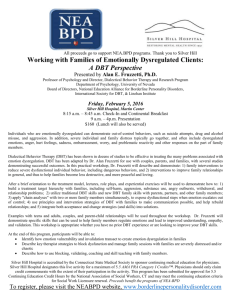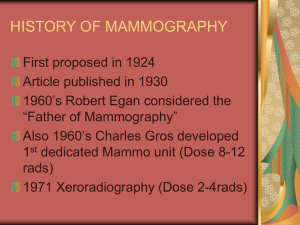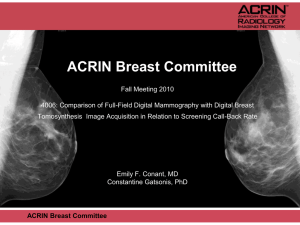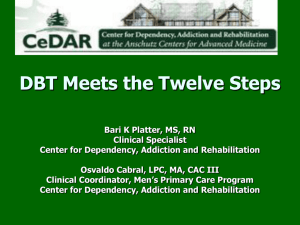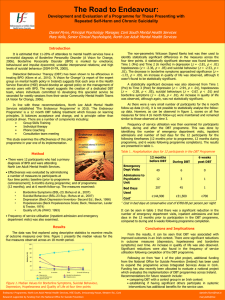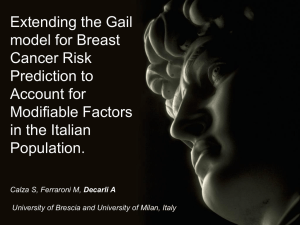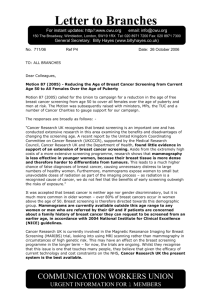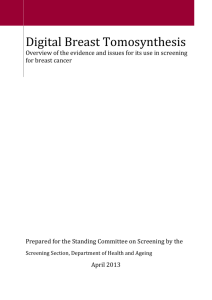September 20, 2000 - American College of Radiology
advertisement
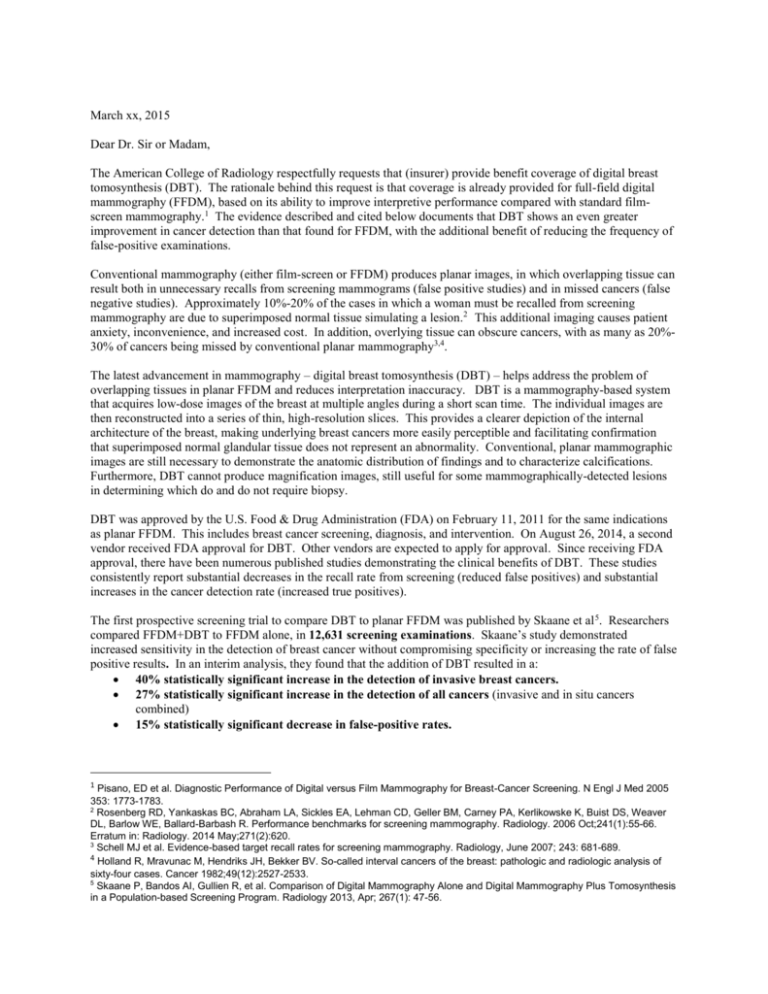
March xx, 2015 Dear Dr. Sir or Madam, The American College of Radiology respectfully requests that (insurer) provide benefit coverage of digital breast tomosynthesis (DBT). The rationale behind this request is that coverage is already provided for full-field digital mammography (FFDM), based on its ability to improve interpretive performance compared with standard filmscreen mammography.1 The evidence described and cited below documents that DBT shows an even greater improvement in cancer detection than that found for FFDM, with the additional benefit of reducing the frequency of false-positive examinations. Conventional mammography (either film-screen or FFDM) produces planar images, in which overlapping tissue can result both in unnecessary recalls from screening mammograms (false positive studies) and in missed cancers (false negative studies). Approximately 10%-20% of the cases in which a woman must be recalled from screening mammography are due to superimposed normal tissue simulating a lesion.2 This additional imaging causes patient anxiety, inconvenience, and increased cost. In addition, overlying tissue can obscure cancers, with as many as 20%30% of cancers being missed by conventional planar mammography3,4. The latest advancement in mammography – digital breast tomosynthesis (DBT) – helps address the problem of overlapping tissues in planar FFDM and reduces interpretation inaccuracy. DBT is a mammography-based system that acquires low-dose images of the breast at multiple angles during a short scan time. The individual images are then reconstructed into a series of thin, high-resolution slices. This provides a clearer depiction of the internal architecture of the breast, making underlying breast cancers more easily perceptible and facilitating confirmation that superimposed normal glandular tissue does not represent an abnormality. Conventional, planar mammographic images are still necessary to demonstrate the anatomic distribution of findings and to characterize calcifications. Furthermore, DBT cannot produce magnification images, still useful for some mammographically-detected lesions in determining which do and do not require biopsy. DBT was approved by the U.S. Food & Drug Administration (FDA) on February 11, 2011 for the same indications as planar FFDM. This includes breast cancer screening, diagnosis, and intervention. On August 26, 2014, a second vendor received FDA approval for DBT. Other vendors are expected to apply for approval. Since receiving FDA approval, there have been numerous published studies demonstrating the clinical benefits of DBT. These studies consistently report substantial decreases in the recall rate from screening (reduced false positives) and substantial increases in the cancer detection rate (increased true positives). The first prospective screening trial to compare DBT to planar FFDM was published by Skaane et al 5. Researchers compared FFDM+DBT to FFDM alone, in 12,631 screening examinations. Skaane’s study demonstrated increased sensitivity in the detection of breast cancer without compromising specificity or increasing the rate of false positive results. In an interim analysis, they found that the addition of DBT resulted in a: 40% statistically significant increase in the detection of invasive breast cancers. 27% statistically significant increase in the detection of all cancers (invasive and in situ cancers combined) 15% statistically significant decrease in false-positive rates. 1 Pisano, ED et al. Diagnostic Performance of Digital versus Film Mammography for Breast-Cancer Screening. N Engl J Med 2005 353: 1773-1783. 2 Rosenberg RD, Yankaskas BC, Abraham LA, Sickles EA, Lehman CD, Geller BM, Carney PA, Kerlikowske K, Buist DS, Weaver DL, Barlow WE, Ballard-Barbash R. Performance benchmarks for screening mammography. Radiology. 2006 Oct;241(1):55-66. Erratum in: Radiology. 2014 May;271(2):620. 3 Schell MJ et al. Evidence-based target recall rates for screening mammography. Radiology, June 2007; 243: 681-689. 4 Holland R, Mravunac M, Hendriks JH, Bekker BV. So-called interval cancers of the breast: pathologic and radiologic analysis of sixty-four cases. Cancer 1982;49(12):2527-2533. 5 Skaane P, Bandos AI, Gullien R, et al. Comparison of Digital Mammography Alone and Digital Mammography Plus Tomosynthesis in a Population-based Screening Program. Radiology 2013, Apr; 267(1): 47-56. The Screening with Tomosynthesis Or Routine Mammography (STORM) trial6 was a prospective comparative study of 7292 women from two institutions. The cancer detection rate was 51% higher for FFDM+DBT than FFDM alone, while FFDM+DBT was also associated with a 17% statistically significant reduction in false positive recalls. Haas et al.,7 in a study of 6100 women receiving FFDM+DBT, reported a 30% statistically significant reduction in recall rate with DBT screening. Rose et al.8, in a study of 9499 women receiving FFDM+DBT, reported a 53% increase in the detection of invasive cancers and a statistically significant increase in the positive predictive value for screening recalls (PPV1) with FFDM+DBT compared to FFDM alone. The largest study to date, by Friedewald et al, was published in 2014 in the Journal of the American Medical Association.9 This multi-center trial compared 281,187 conventional mammograms to 173,663 DBT exams. The study reported the following findings: A 41% statistically significant increase in the detection of invasive breast cancers. A 29% statistically significant increase in the detection of all breast cancers. A 15% statistically significant decrease in women recalled for additional imaging. A 49% statistically significant increase in positive predictive value for recall (PPV1). A 21% statistically significant increase in positive predictive value for biopsy (PPV3). Given the above information, CMS decided to add additional reimbursement for Medicare patients receiving DBT, beginning in January of 2015. In conclusion, the American College of Radiology affirms that: DBT addresses a primary limitation of planar FFDM in the detection of breast cancer. DBT is not investigational. The term investigational implies that studies have not been performed demonstrating improved performance compared with FFDM. Numerous large-scale studies of DBT already have demonstrated this benefit. Demonstrated benefits of DBT, compared to FFDM alone, include significant increase in detection of invasive breast cancer and significant reduction in unnecessary recall from screening mammography. Additional benefits include decreased patient anxiety and inconvenience. DBT leads to improved detection of early breast cancer. Smaller cancers require fewer and/or less invasive surgical procedures, less frequent and less toxic chemotherapy, and more frequent use of breast preservation surgery, all of which can result in improved patient outcomes . Therefore, the American College of Radiology recommends coverage of digital breast tomosynthesis as a medically necessary screening and diagnostic mammography service. Please note that the American College of Radiology (ACR) has released a position statement requesting that all insurers cover this service. A copy of that statement is attached for your review. Thank you for your consideration and please feel free to contact us if you have any questions or require any additional information. 6 Ciatto S, Houssami N, Bernardi D, Caumo F, Pellegrini M, Brunelli S, Tuttobene P, Bricolo P, Fantò C, Valentini M, Montemezzi S, Macaskill P. Integration of 3D digital mammography with tomosynthesis for population breast-cancer screening (STORM): a prospective comparison study. Lancet Oncol. 2013 Jun;14(7):583-9. 7 Haas BM, Kaira V, Geisel J, Raghy M, Durand M, Philpotts LE. Comparison of tomosynthesis plus digital mammography and digital mammography alone for breast cancer screening. Radiology 2013; 269:694–700 8 Rose SL, Tidwell AL, Bujnoch LJ, Kushwaha AC, Nordmann AS, Sexton R. Implementation of breast tomosynthesis in a routine screening practice: an observational study. AJR 2013; 200:1401–1408 9 Friedewald S M, Rafferty E A, Rose S L, Durand M A, Plecha D M, Greenberg J S, Hayes M K, Copit D S, Carlson K L, Cink T M, Barke L D, Greer L N, Miller D P, Conant E F Breast Cancer Screening Using Tomosynthesis in Combination with Digital Mammography, JAMA. 2014;311(24):2499-2507

